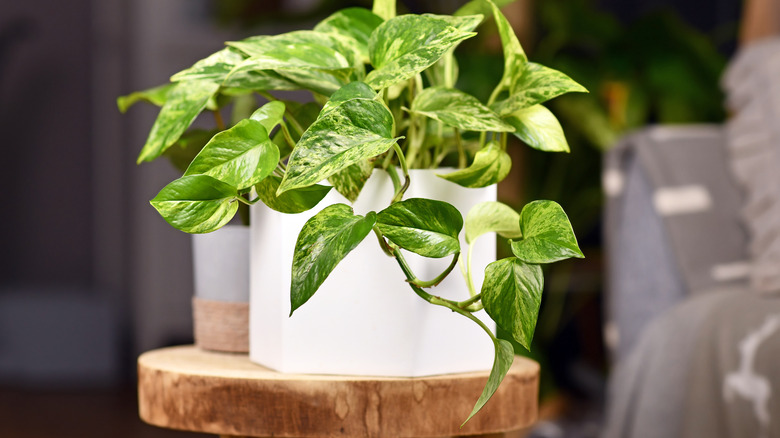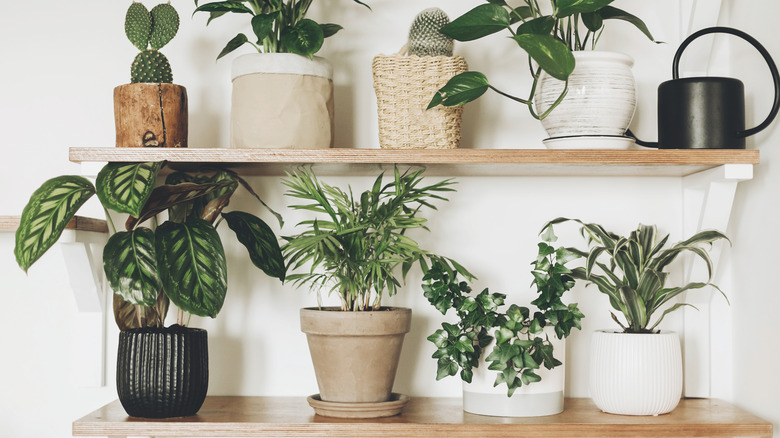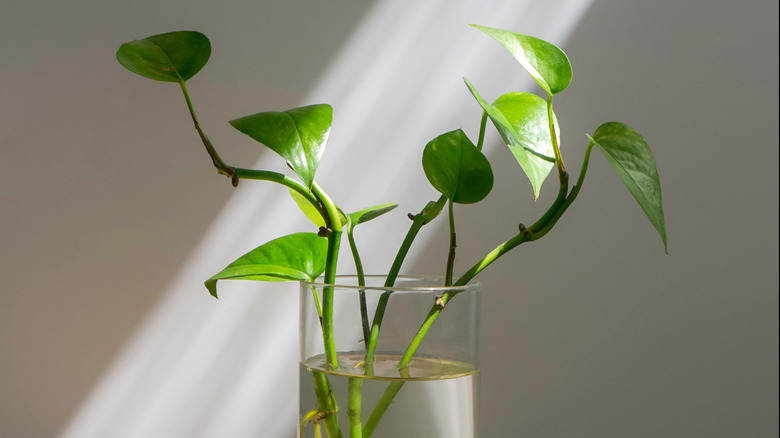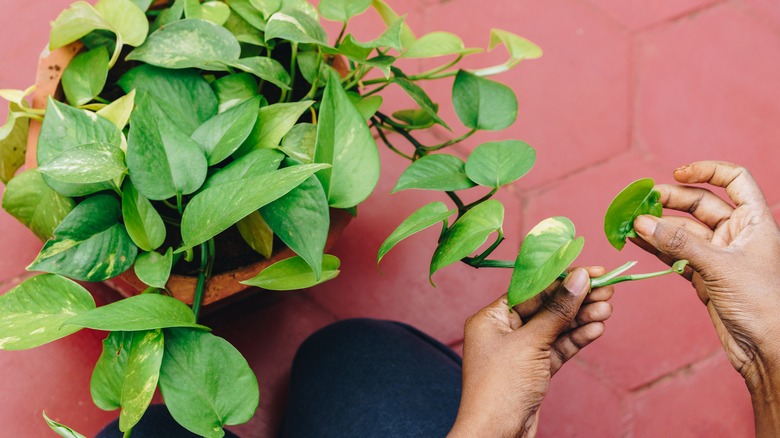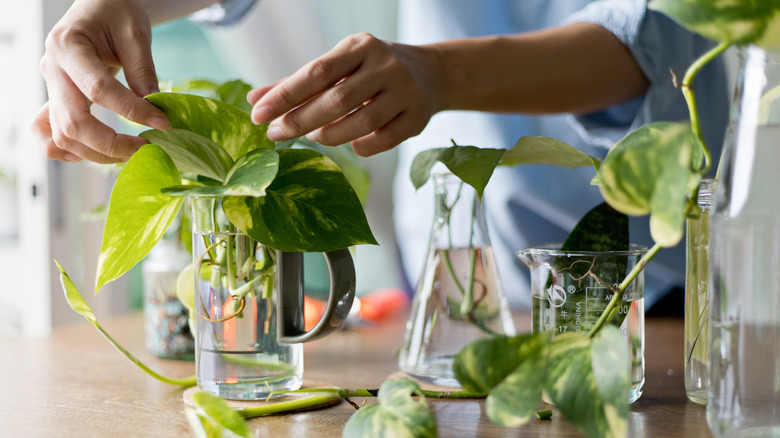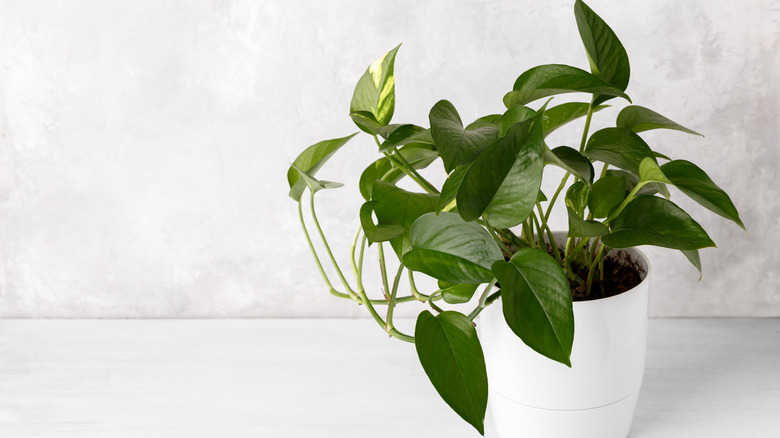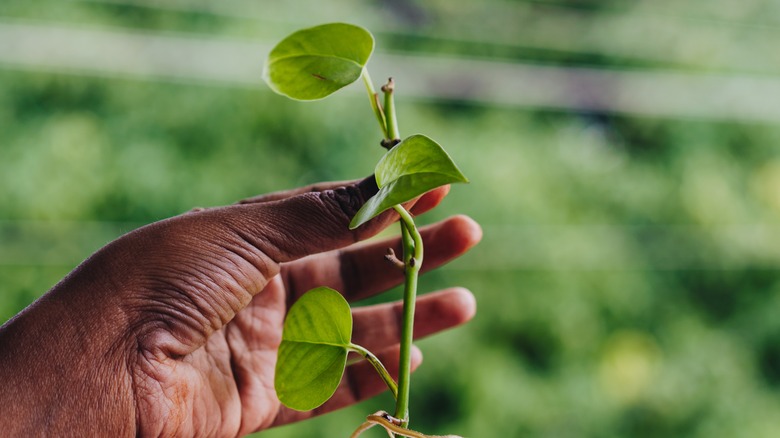How To Actually Propagate Your Pothos Plant
Pothos is one of those easy houseplants anyone can keep alive. They're a vining plant with heart-shaped green leaves with white or yellow variegation. According to House Plants Experts, they thrive in partial shade and need to be watered about every two weeks. If you have small children or pets, you need to be careful with pothos plants because they are toxic. However, if you are set on owning a pothos plant, you can style their long trailing vines to climb across your walls and keep them far out of reach from kids and dogs.
Neglecting a pothos plant won't do much harm. The most that may happen is their leaves will lose their variegation, and their vines will grow slower. If you manage to kill a pothos plant, you will likely have time to save a few good cuttings before it's too late. You can propagate those cuttings in either water or dirt to grow an entirely new pothos plant. Here is how!
Why you should propagate your pothos
Propagating a pothos plant is so popular because of how easy it is. With minimum effort, you can be surrounded by new plants to either gift, sell, or keep for yourself. It's important to trim your mature pothos plants to keep them from overgrowing and becoming leggy. Propagating is a good way to use trimmings or save a plant that's on the brink of death. According to Indoor Plants World, having a couple of pothos plants throughout your home can even purify the air from formaldehyde, benzene, and carbon monoxide. It's a win, win situation!
What you need to propogate
The most important thing you need is a mature pothos plant. You will need scissors, gardening shears, or anything sharp to create the cutting. You will need to disinfect your chosen utensil with rubbing alcohol before using them, so you don't spread plant diseases, explained Gardening Know How. You will also need a container for your cutting, as well as dirt and water.
Propagating in water
Propagating your pothos plant in water is one of the most satisfying methods. Many people choose this method because of the aesthetically pleasing glass jars used. If you're the kind of person who needs to see your plants grow, you should choose this method because you can see the root system developing in the water. Propagating in water also allows you to take multiple cuttings from one vine on your pothos, according to Erica by Design. However, choosing to propagate in water makes your cuttings more susceptible to root rot.
How to get a cutting
Getting a cutting from your mother plant is the hardest part of the process, and it's not that hard. Once you have your shears clean, you need to locate the node or aerial root at the stem of your plant. A node is a brown bump coming out of the bottom of the stem where the leaves branch off from. You want to cut in the gaps between each node on the stem. Erica by Design has a video that shows exactly where to make your cuts.
Get a container
Clear glass jars are the best choice when propagating in water. According to The Garden Professors, some people believe that using blue or red-colored glass jars encourages root growth, but this has been proven incorrect. Using clear glass allows you to track root growth, know when to add more water, and check for root rot. However, your cuttings are more susceptible to root rot when they're propagated in water, so keep an eye on their progress. If your plant's roots are slimy and a yellow-brown color, you have root rot. To remedy it, cut off the infected area.
Propagate it in water
To propagate your cuttings in water, you need to add water to your glass jar and place the cuttings in with the leaves sticking up above the water. Tap water is okay as long as it isn't overly chlorinated, but the best water to use is rainwater or bottled water. Epic Gardening also suggests adding liquid fertilizer to add nutrients for your pothos to eat and grow. When your cutting develops a strong root system, you can transplant it to dirt after about a month.
Propagating it in dirt
Propagating your pothos in the dirt is a great choice if you're looking to set it and forget it. This is the easiest propagation method and leaves you with less work in the long run. Your cuttings will develop thicker and stronger roots in the soil, and you won't have to transplant them into dirt later, like with water propagation. According to eHow Garden, you can easily create a whole new pothos plant by taking multiple clippings from your original houseplant and rooting them in the potting soil. You can take as many as 10 clippings in one round!
How to get a cutting for dirt propagation
Like with water propagation clippings, using clean shears to cut dirt propagation clippings is important. When propagating in the dirt, you still need to locate the mother plant's nodes, but instead of cutting between each node, you will only cut at the end of the vine. Cut the vine right near the dirt for best results, as per eHow Garden. That means you can root longer vines if you want a more robust-looking plant.
Choose a container for dirt clippings
The pot you use is important when propagating in the dirt. You want a pot with proper drainage holes and made from a porous material, such as terracotta. The pot should also be small because your cutting will develop its root system before growing new leaves, and if you have a large pot, your plant will spend all of its time growing roots to fill it. You also want to mix well-draining soil. Gardening Know How recommends creating a mix of 1 part peat moss and 1 part perlite. However, if this isn't accessible to you, premixed potting soil is fine.
Root your clippings in the dirt
Potting your pothos cuttings is simple. Using your finger, a shovel, or a wooden skewer, create a small hole in pre-watered soil. Then insert your pothos cutting with the cut side pointing down into the dirt. Rooting hormone can also be used when propagating in the dirt to help grow roots. Pothos is a resilient plant, so this isn't necessary, but it is helpful. According to Empress of Dirt, the root system will take about four to six weeks to grow. All you need to do is water your pothos and wait for new leaves to sprout.
